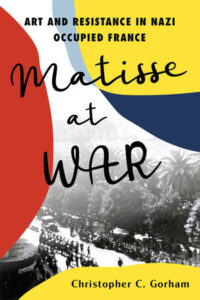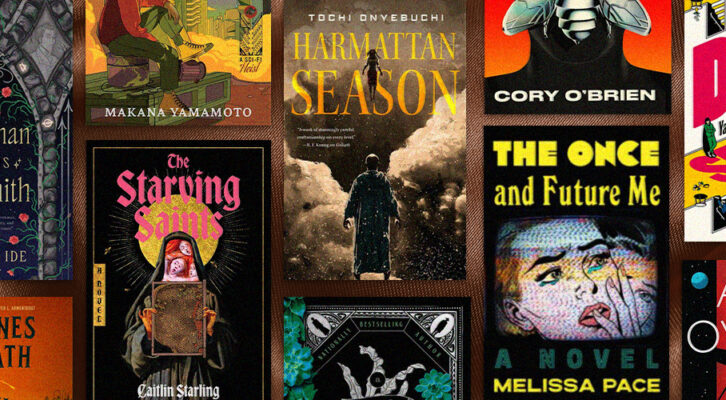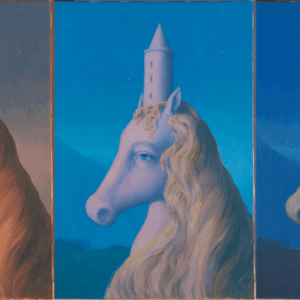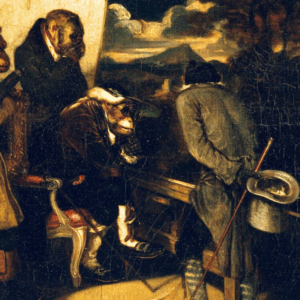
When Picasso Saved Matisse’s Paintings From the Nazis
Christopher C. Gorham on Art Theft and Artistic Solidarity in Occupied France
After subduing Paris in the summer of 1940, Adolf Hitler launched “a second blitzkrieg,” in the words of scholar Frederic Spotts, “with the intention of making Germany as supreme culturally as it was militarily.” On one front of this offensive was the attempt to erase the rich and complex cultural life found in the French capital city. Two thousand titles deemed offensive to the Nazi regime were removed from its libraries: histories; biographies; classics like All Quiet on the Western Front; works by the Communist poet Louis Aragon; and by Jews, including Albert Einstein, Sigmund Freud, and Thomas Mann. Writers Albert Camus, Antoine de Saint-Exupéry, and Georges Simenon were among those who faced censorship. “Politically,” complained the feminist writer Simone de Beauvoir, “we found ourselves reduced to a position of impotence.”
Before a gallery could mount a show, approval was required from the German Propaganda-Abteilung, installed in offices on Avenue des Champs-Elysées. A referat from the bureau would then attend the live show to act as a spy, ensuring compliance. As if to prove the magnificent treasures within Paris now belonged to the German dictator, the statue of Great War French hero General Mangin—which outraged the Führer—was destroyed.
The relationship between Henri Matisse and Pablo Picasso had, in part, been shaped by war.
A simultaneous assault was waged on private art collections and public museums. Nazi bureaucrats entered each bank and inventoried the contents of safes, strongrooms, and vaults. Once cataloged, items were confiscated with typical Teutonic efficiency and sent to Germany or liquidated for Hitler’s war effort. Foreign stocks and bonds, precious metals, and fine jewelry were of particular interest to the Germans. Valuable paintings looted mainly from prominent French Jewish families and characterized as “ownerless” were warehoused in the German Embassy, the Musée de Louvre, and the Jeu de Paume. By 1944, the Special Staff for Pictorial Art could gloat over 21,903 stolen artworks, including masterpieces by Gainsborough, Goya, Rembrandt, Van Dyck, Velázquez, and Vermeer. “This collection can compare with those of the finest European museums. It includes many works of the foremost French masters, who up to now have been only inadequately represented in the best German museums.”
Some French cultural treasures remained beyond the reach of the Germans. Nearly a year had passed since national Museum Director Jacques Jaujard ordered priceless artworks and objets crated and carried away. At Loc-Dieu Abbey, seventy-five miles north of Toulouse, the local curator uncrated the seventeenth-century paintings of Nicholas Poussins to check on their condition. A group of children and farmers approached the paintings, which were set against haystacks in the late-summer sun. One of the children began to clap; then all of them; the farmers tossed their spades to the ground and joined in. “Follow me,” said the curator, overcome with emotion. He took them inside the abbey, where they stood before a simple wooden crate with three red dots and the words “Musée Nationale.” He lifted the lid to reveal Leonardo da Vinci’s Mona Lisa.
The Old Masters were not the only target of the occupiers. When a Nazi task force plundered the gallery and apartment of noted art dealer Paul Rosenberg, they made off with several Matisses, including Woman Seated in an Armchair and Girl in Yellow and Blue with Guitar. As if driving the Jewish art dealer from his home and looting its contents were not enough, the Nazis then transformed Rosenberg’s gallery into the office of the Institute for the Study of the Jewish Question, using the space to organize Le Juif en France, one of the largest anti-Semitic exhibitions in history, an act of grotesque irony. For Parisian Jews in 1941 and 1942, these thefts were compounded by a cascade of other degradations, including the loss of distinguished positions at the Sorbonne, in banking, science, and medicine, with more devastation to come.
*
Woman Seated in an Armchair and Girl in Yellow and Blue with Guitar were chosen for the personal collection of Reichsmarschall Hermann Göring, Nazi Germany’s second-in-command, who had “carefully vetted” the stolen Matisse works. A photo from December 1941 shows a seated Göring at the Jeu de Paume ogling two more Matisses set before him by his aides: Daisies and Odalisque with a Tambourine. That the artist was in the collections of Jewish-American families, such as that of Gertrude Stein, did not dissuade the Luftwaffe chief from adding a fifth Matisse to his collection, Woman in Blue in Front of a Fireplace. As he gazed upon the profile of the handsome woman in a blue ruffled dress, Göring could not have known the model was Matisse’s companion Lydia Delectorskaya.
There were also Matisses in the two dark storerooms in the Jeu de Paume set aside for “Degenerate Art,” in addition to the crates bound for Reichsmarschall Göring; but something vastly more valuable was at risk: Henri Matisse’s private collection. Much of his life’s work, as well as pieces by Cézanne, Courbet, and Renoir, were in his vault in the basement of Banque Nationale pour le Commerce et l’Industrie located on Boulevard des Italiens. “I know what refined and robust removal men the Germans can be,” Matisse worriedly wrote to his son Pierre.
His estranged wife Amélie and daughter Marguerite were living just a short distance from the bank in an apartment on Rue de Miromesnil. Amélie had refused to leave the capital, declaring “there may be something for me to do.” She had been “a semi-invalid” by the end of her marriage, but with the war she acquired “a new charge of energy and self-reliance. It was almost as if she were in training for an active, and quite possibly a dangerous, life.” The resourceful Madame Matisse, who had once run her world-famous husband’s art career, again had a cause: the defense of Paris and its treasured artworks.
While Matisse and Lydia were en route to Nice, the German removal men paid a visit to Banque Nationale pour le Commerce et l’Industrie. The “technicians” were two German soldiers, who demanded of the bank manager to be taken to the huge circular subterranean chamber so they could begin the inventory. There were three vaults for artwork; Matisse owned one. Whenever possible, vault owners raced to their bank to be present for the process, lest their cherished valuables go missing. Would the bank manager—a friend of Matisse—alert the family members in time?
As the two soldiers descended the elevator to the three art vaults, escorted by the bank manager, neither Madame Matisse nor Marguerite was present. Instead, the Germans would be led through the vaults by the owner of the other two. Pablo Ruiz Picasso.
The relationship between Henri Matisse and Pablo Picasso had, in part, been shaped by war. In the years prior to the Great War, they had both been flowers in the creative hothouse of Montmartre. The outbreak of war scattered the international art cohort. The Germans disappeared; some, like the Expressionist August Macke, who was inspired by Matisse, died for their Kaiser. Georges Braque and André Derain donned the horizon blue of the French Army. The Spanish artists, Picasso and Juan Gris, continued their work in France. But for all of them, according to Françoise Gilot, life was never the same. “The arguments, the companionship, the rivalries, the sense of humor, and the hope and enthusiasm for the avant-garde were over. From then on, each painter had to fend for himself.” For Matisse, this meant a move to the southern light of Nice to wage his artistic battle with himself. For Picasso, it meant the evolution of Cubism.
In the mid-1930s, the Spanish Civil War between the fascist forces of Franco and the nationalists was a harbinger that a second general European war lay just over the horizon. At this moment, the friendship between the two giants deepened. They were recognized leaders of an artistic movement denigrated by Nazi leadership as Marxist-Jewish decadence. Their opposite numbers in Germany, like Paul Klee, fled Nazi Germany or stayed and suffered, like Felix Nussbaum. Instead of experimental modernism, the work favored by the Nazi regime was “the exaggerated musculature of warriors and athletes…middlebrow descriptive art extolling the virtues of young SS athletes and or fair-haired women producing babies” for the Third Reich. In Mussolini’s Italy, it was a modern replay of the Roman Triumph, but instead of victorious legions carting conquered treasure, it was “flaccid Fascist statuary.”
In this artistic front of war, Matisse and Picasso were on the same side. They had passed from the fin de siècle through the portal of modernity that was the Great War. Theirs had been a guarded cordiality, but now, “they shared the same fate of being attacked and often denounced.” “A deep emotional bond was sealed. After all, no one could understand them as they did each other.” For all their differences in background, temperament, and approaches to art, Matisse and Picasso both venerated Cézanne, Delacroix, Manet, and van Gogh. They exchanged paintings with each other and paid homage to each other with works including elements of the other’s style. Picasso’s sculptures seemed, to Gilot, to be “blown-up, radicalized replicas of Matisse’s own [earlier] work.”
They were allies against a common enemy, but the two men were vastly different artistically, and temperamentally. Twelve years older and speaking from the perch of propriety he’d learned early in life in Picardy, Matisse at first frowned on the Andalusian’s “rebellious attire and extravagant behavior.” Matisse dressed the part of a British gentleman and gazed at his conversation partners with a serenity that bordered on a trance. Picasso was the “fierce bull,” his large head and shoulders bent forward, his feet stamping the floor. While Matisse harbored an almost spiritual “global vision of the universe as permeated by love,” Picasso “was possessed by the desire to know, to analyze, to discover, even if it meant to destroy or to divide.”
There was a vibration and luminosity somewhere out there to Matisse; to Picasso there was a latent malignancy. “As complimentary as red and green, as opposed as white and black,” the two developed a “mutual respect” and an “appreciation of each other’s greatness.” Matisse, sober in mind and appearance, with sonorous, albeit economic French. By contrast, Picasso’s “erratic pronouncements” filtered through his imperfect French and his “romantic aura” became “enticing enigmas.” Friendly but formal, the two men waged an elegant and knightly war with each other over artistic ideas—what the French call la guerre en dentalle,” a lace war.
Far from a knightly war, the German advance in 1941-1942 against France was a dirty one, with thieving of private property and menace against civilians. As an enemy of the Spanish fascist Franco, Pablo Picasso was persona non grata in addition to being an artistic enemy of the Reich. He was taking a considerable risk by being in the bank vaults with the two soldiers.
In the basement catacomb, Picasso rushed the two inspectors “from one room into the next, pulling out canvases, inspecting them, shoving them back in again, leading the soldiers around corners, [and] making wrong turns.” Muttering in his Spanish-inflected French, Picasso gestured to paintings of angles, planes, and fragmented forms. Trying to keep up, the two Germans scribbled in their notebooks, but “they were all at sea”; they “didn’t know what they were looking at,” which Picasso exploited. “Germans always have a respect for authority, whatever form it may take. The fact that I was somebody everyone had heard of and I came there myself and gave them exact details of sizes, values, and dates—all that impressed them very much. And they couldn’t imagine anyone telling them a story that might cost him very dear if he had been found out.”
Thoroughly confused in the unfamiliar world of Cubist shapes and Surrealistic phantasmagoria, the soldiers stepped into the dark hall and stood in front of Matisse’s vault.
“Oh, we’ve seen these,” Picasso said.
Satisfied, one of the soldiers asked in French: Alors, que valent toutes ces choses? (Well then, how much are all these things worth?)
They were allies against a common enemy, but the two men were vastly different artistically, and temperamentally.
Picasso looked up the circular column to the lights of the bank lobby above, as if doing calculations in his head. In the three vaults were the treasures of the best-known modernist painters in the world, works that might one day adorn the walls of great collections and conservatories.
“Huit milles francs.”
One of the soldiers looked from Picasso to his notebook, and jotted down the figure, repeating as he wrote: huit…milles…francs.
Picasso’s figure must have had the intended effect, because the two soldiers had no desire to crate and carry away the contents—not for $178.
By remaining in France during the Occupation, both Matisse and Picasso were taking a risk. Matisse would have his own encounters with the Germans in the south, but Picasso, who remained in Paris at his apartment and studio at 7 Rue des Grands Augustins, was a ready target for harassment. Every few weeks, three or four Germans in suits and fedoras would appear at his entryway.
“This is where Monsieur Lipchitz lives, isn’t it?”
“No,” replied Picasso’s secretary, Jaime Sabartés. “This is Monsieur Picasso.”
“Oh, no. We know it’s Monsieur Lipchitz’s apartment.”
“But, no,” Sabartés would insist. “This is Monsieur Picasso.”
“Monsieur Picasso isn’t a Jew, by any chance?” said one of the men.
The men well knew that sculptor Jacques Lipchitz was in the United States, and Picasso was not Jewish, but it didn’t matter.
“We’re coming in to search for papers.”
The disorder of Picasso’s studio was an invitation to them to rummage through his paintings and belongings, leaving behind tipped-over works, pulled-out drawers, and papers on the floor. “They insulted me, called me a degenerate, a communist,” Picasso told his friend André-Louis Dubois after one of the episodes. Once, the visitors stole the bed linens; on other occasions, they threatened further damage. “They kicked the canvases. They told me they’d be back.”
The first Nazi official to visit Picasso during the war became part of an often-told story that may be apocryphal, but which was nonetheless related by Alfred Barr, Matisse’s first biographer. Not long after the conquest, so the story goes, Otto Abetz, the infamous, though cultivated, German agent, called on Picasso. Picasso received him coldly, refused his offer of fuel, and showed him the door. On his way out of the studio Abetz noticed a photograph of Guernica. “Ah, Monsieur Picasso,” he said, adjusting his monocle, “so it was you who did that.”
“No,” replied Picasso as he closed the door, “you did.”
__________________________________

From Matisse at War: Art and Resistance in Nazi-Occupied France by Christopher C. Gorham. Copyright © 2025. Reprinted with permission from Kensington Books.
Christopher C. Gorham
Christopher C. Gorham is a lawyer and teacher of modern American history at Westford Academy, outside Boston. He has degrees in history from Tufts University and the University of Michigan, where he studied under legendary labor historian Sidney Fine. He has a J.D., summa cum laude, from Syracuse University College of Law, where he served on the editorial staff of the Syracuse Law Review. His writing has appeared in the Washington Post and in online journals. He and his wife Elizabeth live in Watertown and Chatham, Massachusetts.



















